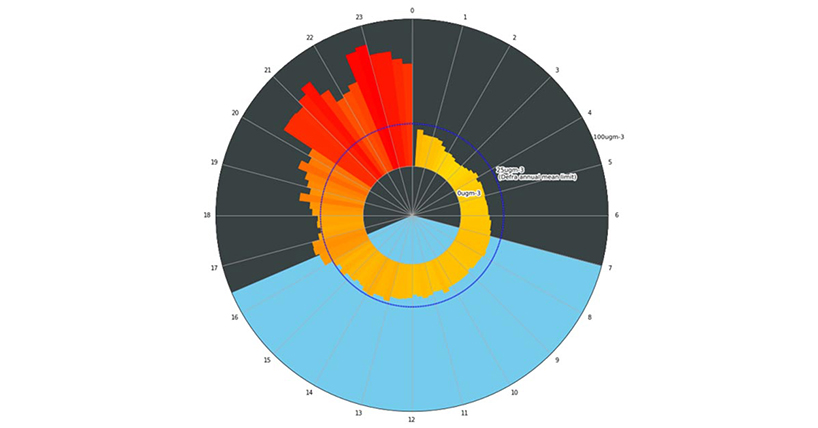Bonfire night
Air pollution levels rocket on bonfire night
Published on: 5 November 2019
Fireworks and bonfires cause air pollution levels to soar on November 5th, thousands of sensors collecting data across Newcastle and Gateshead have shown.
Measuring levels of fine particulate matter (PM2.5) the data shows that levels rocketed between 8pm and midnight last year on bonfire night, rising from a daytime level of around 20 micrograms/m3 to almost 80 micrograms/m3 just before 11pm.
This is against an annual average of 25 micrograms/m3 and eight times the World Health Organisation’s recommended limit of 10 micrograms/m3.
The data has been collected as part of Newcastle University’s Urban Observatory - the UK’s largest urban experiment collecting data about 60 different urban indicators, everything from energy use, rainfall and flooding to air pollution, traffic flow, noise and social media activity.

Tackling air pollution
Newcastle University’s Professor Phil James, who leads the EPSRC Urban Observatories partnership, explains:
“The air pollution data we collected over 24 hours last bonfire night paints a really striking picture of the impact the fireworks and bonfires are having on air quality.
“It’s perhaps not surprising - you can often smell the gunpowder and smoke in the air on November 5th – and the low cloud cover that night exacerbated the situation.
“This graph shows us just one night, but what it demonstrates is the level of data we are starting to collect and how we can start to use this to understand how our cities should be managed and developed in the future.”
PM2.5 are very small dust particles caused mainly by manmade systems such as vehicle exhausts and are particularly damaging to our health.
Bonfire night 2018 between 6pm and midnight was the highest value for PM2.5 recorded last year, with a median value of 56ug/m3 against a normal background of between 10 ~ 20 ug/m3. DEFRA’s requirements for annual average value is 25ug/m3.
"If it was bonfire night every night then we’d have a problem but a one off is unlikely to cause any long term harm," says Professor James.
Children are especially vulnerable to air pollution and one of the projects being led by the Newcastle team - SenseMyStreet - has involved local communities monitoring the air pollution, traffic and noise around homes and schools.
"By 2050, around 70 per cent of the world’s population will live in cities,” says Prof James.
“We know there is an urgent need to reduce air pollution in our cities by reducing congestion and cutting carbon emissions. But if we look at this in isolation then we’re storing up a whole host of other problems further down the line.
“A study from a team in Edinburgh, for example, suggested the knock-on effect of reducing air pollution would be a reduction in cloud cover and therefore an increased risk of heatwaves in our cities.
“At the same time, we heard from the Environment Agency about how we need to adapt our infrastructure and stop building on flood plains to become more resilient to climate change and future flooding.
“But another study by colleagues right here in Newcastle shows that if we are to move development away from the river banks and coastlines, while still protecting our green spaces and reducing sprawl, it really only leaves two options; either we shrink our homes or we develop in higher heat risk areas such as inner cities – once again increasing the number of people exposed to extreme heatwaves.
“Everything in a city is connected so we can’t look at problems in isolation. It’s no good solving one problem only to create three more.
“What we are trying to do through the Urban Observatories is to understand exactly how our cities interact. Once we have that baseline then we can see not only the positive impact when we implement a change, but also any unintended consequences and adapt our approach – like following the ripples on a pond when we throw stones.”
UK’s largest set of real-time data
Newcastle University’s Urban Observatory is based on the city’s Helix site, an exemplar of sustainable urban development and home to the University’s School of Computing and the National Innovation Centre for Data.
Over 3600 sensors are deployed across Newcastle and Gateshead alone, adding 5000 new observations every minute. It is the largest deployment of urban sensing in the UK and the largest collection of open, environmental, real-time data in Europe.
The Urban Observatories are a partnership between the universities of Newcastle, Sheffield and the local councils. And earlier this year the £12m project, funded through the Engineering and Physical Sciences Research Council as part of the UK Collaboratorium for Research on Infrastructure & Cities (UKCRIC), was extended to three more major cities led by the universities of Manchester, Birmingham and Cranfield.
Cities are big complex beasts with overlapping layers of management, jurisdiction, governance and social need.
Understanding the social patterns of a city, says Prof James, is one of the biggest challenges for policy makers and future planners.
“All cities face similar challenges of air pollution, changing energy demands, traffic volumes and where to spend scant resource, but how each city tackles these challenges will reflect local conditions and priorities,” he explains.
“Only by collecting lots and lots of data can you start to see the subtle changes.”
Data is published in real-time and is open for all to view, analyse and use (http://newcastle.urbanobservatory.ac.uk)



